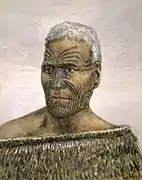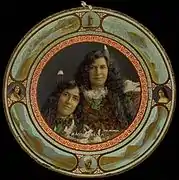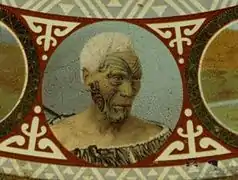Tuterei Karewa
Tuterei Karewa was a chief and a warrior of the Māori iwi (tribe) called the Ngāti Maru. He has been depicted in multiple types of artwork, including photography, watercolor painting, and metalwork. The facial tattoo featured on his face, called a moko, features prominently in these depictions.
Tuterei Karewa | |
|---|---|
 Karewa, c. 1890–1920 with moko (facial markings) enhanced by the photographer | |
| Ngāti Maru leader | |
| Personal details | |
| Born | Tuterei Karewa |
Biography
Details regarding Karewa's birth and death are not documented. Karewa acted as a chief of the Ngāti Maru.[1] Notes maintained by Māori historian W.T. Hammond noted that in the later part of his life, he was living in Kiri Kiri, Thames, and described him as a "handsomely tattooed old Maori warrior."[2] In the 1860s, Karewa also had some political involvement regarding land ownership in New Zealand. Records indicate that in response to European interests in gold prospecting on their lands, Karewa participated in meetings of chiefs of the Hauraki region. Correspondences detailing these meetings indicate Karewa acknowledged European control over certain regions, but maintained that the Hauraki chiefs had independent land rights.[3]
Depictions in artwork
_by_J_Lles_died_1943.jpg.webp)
Karewa was the subject of several pieces of work. Photographer Arthur James Iles documented Karewa in a series of portraits of Māori between 1890 and 1920.[4] The photograph shows Karewa wearing a pihepihe, a type of cloak generally adorned cylindrical tags made of flax.[4] Iles subsequently used his work to have tin plates created overseas, one of which contained a small lithograph of Karewa on the outer edge of the plate among others.[5] He was also the subject of a watercolor painting by artist and soldier Horatio Gordon Robley wearing a garment similar to the Iles photograph.[6]
Reviews of these depictions sometimes comment on the nature of Karewa's face markings, called moko.[1] In the photograph, reviewers have noted that Iles highlighted this tattoo after it was taken,[4] possibly using black paint or another substance.[7] The Oceanic Art Society praised the quality of the facial markings, commenting that Karewa showed the moko "to great advantage."[8]
Gallery
 Watercolor and pencil, by Robley
Watercolor and pencil, by Robley Tin plate featuring Karewa on outer rim.
Tin plate featuring Karewa on outer rim. Tin plate rim, focused on portrait of Karewa
Tin plate rim, focused on portrait of Karewa
References
- Barkan, Elazar; Bush, Ronald, eds. (1995). Prehistories of the future : the primitivist project and the culture of modernism. Stanford, Calif.: Stanford University Press. p. 180. ISBN 0804724865.
- Hammond, W.T. (November 1982). Staples, Gary; Staples, Elaine (eds.). "Notes by Late W.T. Hammond, MBE". The Ohinemuri Regional History Journal. 26. OCLC 173345112. Archived from the original on 2015-01-22.
- "Papers Relative to the Probability of Finding Gold at the Waikato and at the Thames". Appendix to the Journals of the House of Representatives of New Zealand. New Zealand. Parliament. House of Representatives. 1863. p. 3.
- "Description, Tuterei Karewa of the Ngatimaru tribe, North Island, New Zealand". Google Cultural Institute. Museum Victoria. Retrieved 16 October 2014.
- "Iles, Arthur James 1870-1943 [Four tin plates depicting Maori portraits and New Zealand scenes]. Published for Iles, Rotorua, by George Hadfield, Wellington, N.Z. [ca 1901-1905]". Alexander Turnbull Library. National Library of New Zealand. Retrieved 17 October 2014.
- "Robley, Horatio Gordon 1840-1930 :Tuterei Karewa chief of the Ngatimaru tribe. [1890s]". Collections of the Alexander Turnbull Library. National Library of New Zealand. Retrieved 17 October 2014.
- "Gallery". Skin Stories. Public Broadcasting Service. Retrieved 17 October 2014.
- "Maori Art, Maori Soul: Face to Face". OAS Newsletter. Oceanic Art Society. 3 (3): 11. 1997.